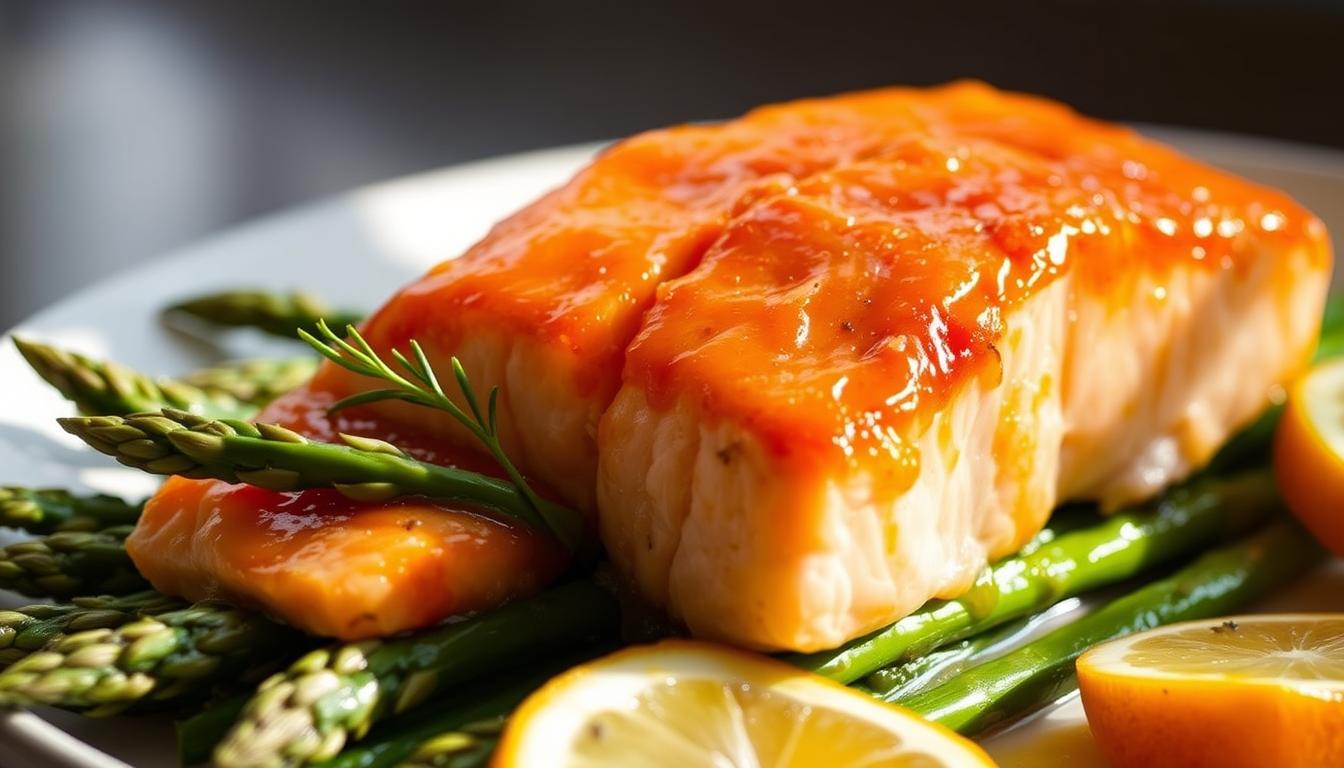Discover the perfect blend of freshness and elegance with this Citrus Poached Salmon with Asparagus. This poached salmon recipe combines flaky salmon fillets, crisp asparagus, and zesty citrus in under 30 minutes. Serving four, it’s a healthy seafood recipe that’s as impressive for dinner parties as it is quick for weeknights.
Poaching gently cooks the salmon in a citrus-infused liquid, locking in moisture and flavor. Lemon and orange juices, paired with herbs like dill and scallions, create a bright base. The 25-minute process ensures tender fish and vibrant veggies, ready to serve with a side of roasted or blanched asparagus.
I’ve crafted this dish to balance taste and nutrition. Each serving offers 43% protein and under 230 calories, making it a smart choice for mindful eating. The salmon’s omega-3s and asparagus’s fiber add extra nourishment, while citrus boosts vitamin C. Perfect for health-focused meals that dazzle!
My Journey with Citrus Poached Salmon
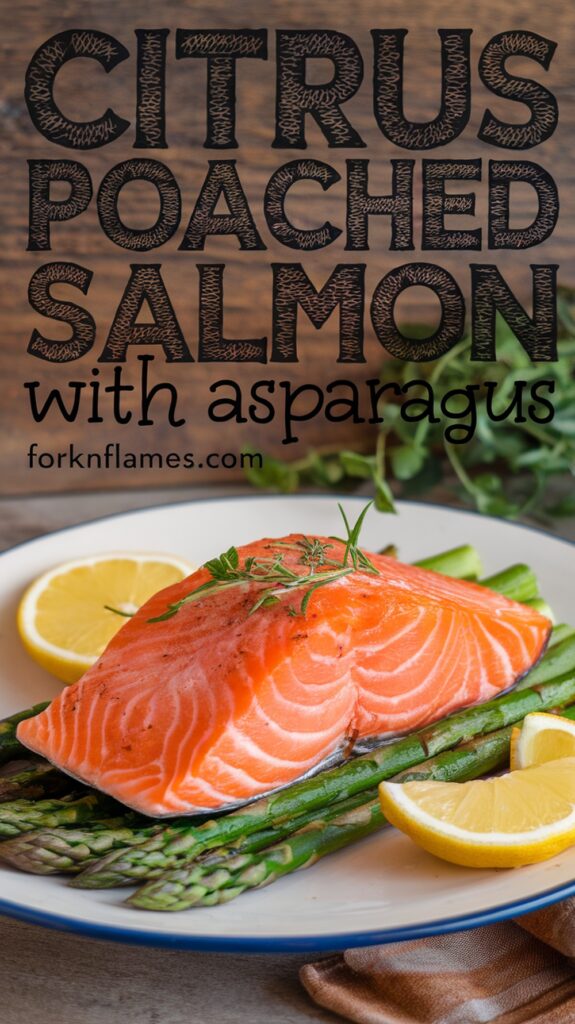
I used to cook salmon in the oven or air fryer. But a scene from The Crown made me try poaching. Seeing the queen enjoy poached salmon inspired me. I started with lemon and white wine vinegar, and it was a game-changer.
The fish was tender, and adding asparagus made it a complete meal. Now, poached salmon is a regular part of my weeknights.
| Step | Time | Details |
|---|---|---|
| Prep | 10 mins | Chop veggies, mix citrus juices |
| Poaching | 15 mins | Cook salmon gently in liquid |
| Total | 30 mins | Quick and easy salmon dinner ready! |
My first tries were with lemon and garlic. But orange and dill took it to the next level. The secret is patience. Cooking it low and slow lets the flavors meld without drying the fish.
Adding roasted asparagus made it even better. Now, it’s my favorite weeknight dinner. And the leftovers are perfect for lunch the next day.
Why This Dish Is a Nutritional Powerhouse
My Citrus Poached Salmon with Asparagus is not just tasty—it’s full of good stuff. It’s a mix of three superfoods on one plate. It gives you protein, vitamins, and antioxidants. Let’s see how each part helps your body.
Omega-3 Benefits from Salmon
Wild-caught salmon is full of omega-3 fatty acids. These are key for your heart and brain. A 4-ounce fillet in this recipe has 24g of protein and 2.4g of omega-3s.
Poaching keeps the nutrients in while keeping fats low. Studies show these fats fight inflammation and help keep blood sugar stable. The American Heart Association says eat fatty fish like salmon twice a week.
Nutrient Profile of Fresh Asparagus
Asparagus adds fiber and antioxidants to the mix. Each spear is packed with vitamins A, C, and K, and folate for cell repair. It’s also low in calories, with just 20 calories per half-cup.
Asparagus is a great source of potassium (1741mg per serving). It’s a low-calorie way to get more fiber and minerals.
The Health Boost of Citrus Fruits
- Vitamin C in citrus boosts iron absorption from salmon, improving energy metabolism
- Citrus compounds like hesperidin may reduce cholesterol oxidation (a heart disease risk)
- Combined with salmon’s protein, this recipe stabilizes blood sugar post-meal
Citrus also adds 259% of your daily vitamin C. This supports your immune system and reduces oxidative stress.
Every bite of this healthy seafood recipe is a mix of taste and nutrition. The 422 calories per serving give you 66% of daily protein needs and 37% potassium. It shows you can have both flavor and nutrition.
Essential Ingredients for This Elegant Meal
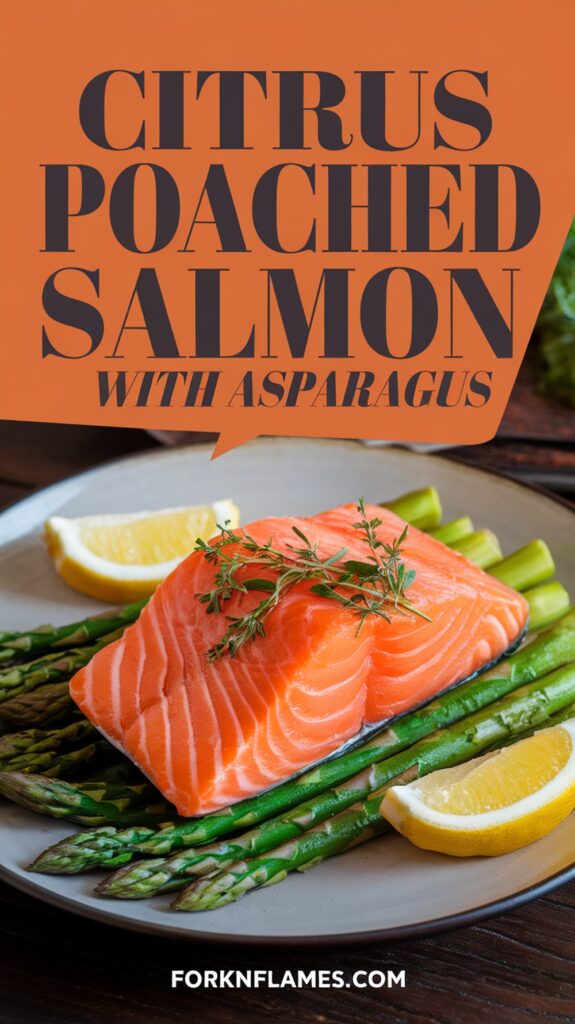
Every ingredient is key to making the Citrus Poached Salmon with Asparagus perfect. Let’s explore what makes this dish stand out:
Selecting the Perfect Salmon Fillets
Opt for center-cut salmon fillets for even cooking. Both wild and farmed salmon are good, but look for shiny skin and a firm feel. Make sure the surface is shiny, not slimy, and has a mild ocean smell.
Frozen fillets need to thaw in the fridge overnight. For a gourmet salmon recipe, 6-ounce fillets are the right size. You can use fillets with or without skin. To remove skin, slip a knife under it before poaching.
Choosing Seasonal Asparagus
Choose spears that are crisp and have tight tips. Thick spears take longer to cook than thin ones. Trim the woody ends by snapping them where they naturally break.
Keep asparagus fresh by storing it upright in water like flowers. Spring’s green spears or winter’s purple ones are great choices.
Citrus Options and Combinations
Don’t just stick to lemons and oranges. Try blood orange zest for a deeper flavor or lime for a zesty kick. Grapefruit with thyme is perfect for winter.
My favorite mix is orange and kumquat for a tangy taste. Adjust the citrus amounts to your liking for the citrus-infused salmon.
Additional Aromatics and Seasonings
Add flavor with dill, shallots, and peppercorns. Captain’s Seafood Seasoning adds a boost of umami. Minced garlic adds warmth.
A tablespoon of white wine vinegar sharpens the poaching liquid. Finish with fresh parsley for brightness. Remember, save asparagus ends for stock!
Kitchen Equipment You’ll Need
My poached salmon recipe doesn’t need a lot of gadgets. A large skillet with tall sides is key. It should be at least 3 inches deep to hold the liquid. A lid is also a must to keep the heat and steam in for even cooking.
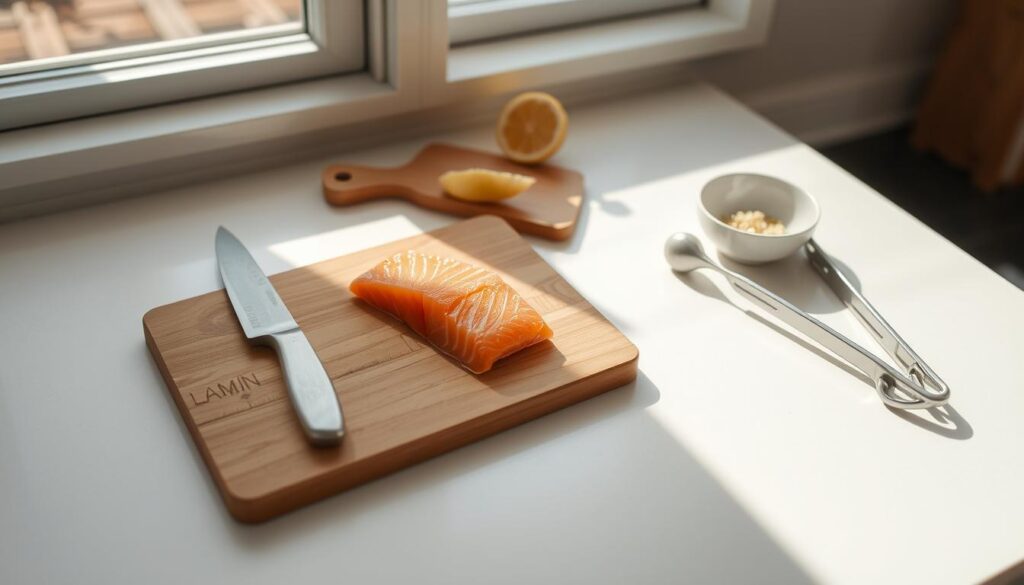
I use a slotted spatula to lift the salmon fillets carefully. This way, I avoid breaking them. An instant-read thermometer helps me check if the salmon is cooked to 145°F. A sharp knife and cutting board are needed for prepping asparagus and citrus.
- Large skillet with lid: Holds liquid and traps steam
- Slotted spatula: Removes salmon without tearing
- Instant-read thermometer: Checks internal temperature
- Cutting board and knife: Prep vegetables and citrus zest
- Timer: Tracks cooking durations
| Item | Purpose |
|---|---|
| Skillet | Essential for poaching liquid retention |
| Thermometer | Ensures safe 145°F internal temp |
| Slotted spatula | Protects flaky salmon texture |
| Cutting tools | Efficient veggie and citrus prep |
Even without fancy tools, making this easy salmon dinner is simple. A baking dish with a lid can replace a skillet if needed. If you don’t have a spatula, tongs work well. Focus on tools that help keep the salmon flaky and the cooking easy.
The Art of Poaching Salmon to Perfection
Mastering the art of poaching keeps your citrus-infused salmon moist and full of flavor. Let’s go through each step to make this poached salmon dish perfect.
Preparing Your Poaching Liquid
Begin with a poached salmon recipe base. Mix orange and lemon juices with water or broth. Add dill, garlic, and a bit of white wine. Simmer until it’s reduced by 20%, then adjust the acidity with sugar if it’s too sharp.
Use enough liquid to cover the salmon halfway—about 6 cups for a 2-lb fillet. Stir in ½ tsp sea salt for seasoning.
Temperature Control Techniques
Keep the water at a gentle simmer, between 140-160°F. Small bubbles should rise steadily. Avoid boiling, as it can overcook the fish.
Use a thermometer to check the temperature. Adjust the heat by lowering it to medium-low. Place a lid slightly ajar to control steam flow.
Timing Your Salmon Just Right
Cook 1-inch thick fillets for 7-10 minutes. Check if it’s done by gently flaking with a fork. It should resist slightly but not be translucent.
Check the internal temp reaches 145°F with a quick-read thermometer. If it’s overcooked, stop at 140°F. The fish will finish cooking with the residual heat.
Handling Asparagus Cooking Times
Add asparagus spears 5 minutes before the salmon is done. For separate cooking, blanch in salted water for 3-4 minutes. Thicker spears need 1-2 extra minutes.
Toss with olive oil and lemon zest for extra citrus flavor.
For a complete guide, explore this step-by-step recipe for visual cues on timing and layering ingredients.
Troubleshooting Common Poaching Mistakes
Mastering the poached salmon dish means knowing how to fix common issues. Here’s how to avoid pitfalls and enjoy a perfectly cooked healthy seafood recipe.
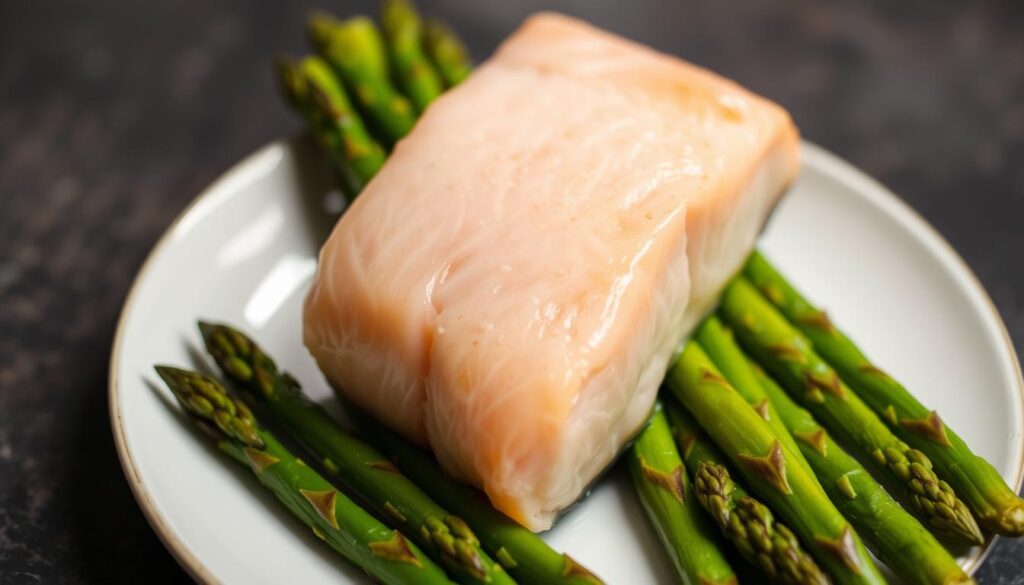
| Problem | Solution |
|---|---|
| Salmon turns rubbery | Cook only until internal temp reaches 145°F. Overcooking breaks down texture. |
| Asparagus turns olive green | Normal color change when cooked in acid. No impact on flavor or safety. |
| Poaching liquid evaporates too fast | Use a lid and check liquid level every 3-4 minutes. Add water if needed. |
| Fish sticks to pan | Ensure liquid covers fillets by ½ inch. Use tongs to gently move fish. |
Avoid microwaving leftovers—store in an airtight container for up to 3 days. Reheat gently on the stove to preserve texture. For seasoning, always taste the liquid before adding salt. I recommend ½ tsp Diamond Crystal kosher salt for balanced flavor.
Citrus Poached Salmon with Asparagus: My Signature Recipe
My citrus salmon recipe is both precise and flexible. It showcases wild-caught salmon’s flaky texture with bright citrus flavors. Let’s explore what makes this dish special.
Ingredient Measurements and Proportions
| Ingredient | Amount | Purpose/Substitutions |
|---|---|---|
| Wild-caught salmon | 16 oz (1 piece or two 8-oz portions) | Choose King or Sockeye for richness; substitute farmed if wild is unavailable. |
| Citrus (lemon, grapefruit, orange) | 1/2 each, peeled and segmented | Florida citrus in season offers peak flavor. Use frozen if fresh unavailable. |
| Asparagus spears | 1 bunch (trimmed) | Look for firm, bright green spears. Substitute snap peas for texture. |
| Chili crunch | 2 tbsp (Momofuku/Mr. Bing from Rollin’ Oats) | Adjust heat with store-bought or homemade versions. |
Step-by-Step Visual Guide
- Combine citrus segments, 1 cup water, and 1 tsp salt in a pot. Bring to a gentle simmer—tiny bubbles clinging to the pot sides.
- Place salmon in liquid. Cook 1 hour at 250°F until flesh flakes gently with a fork—avoid overcooking to prevent dryness.
- Serve over asparagus with chili crunch. Garnish with avocado slices for creaminess.
Making Ahead and Storage Options
- Poach liquid can be prepped 24 hours ahead. Refrigerate and reheat gently.
- Cooked salmon keeps 3 days chilled. Use leftovers in salads or form into cakes with breadcrumbs.
- Freeze poached salmon for 1 month. Thaw overnight before using in cold dishes.
Beautiful Presentation Ideas for Your Table
Turn your citrus-infused salmon into a stunning centerpiece with these easy yet effective ideas. Whether it’s for a fancy dinner or a relaxed brunch, the right presentation can elevate your dish. It adds that special touch of elegance.
- Color Contrast: Place salmon on bright green asparagus spears. Add a drizzle of reduced poaching liquid for a shiny look.
- Citrus Garnish: Arrange lemon or blood orange slices around the plate. Add microgreens or edible flowers for a chic look.
- Herb Highlight: Put salmon on a bed of wilted spinach. Sprinkle with dill and sea salt on top.
| Style | Key Elements | Pro Tip |
|---|---|---|
| Individual Plating | Serve 4-6 portions on white porcelain plates | Drizzle citrus reduction in a zigzag pattern |
| Buffet Display | Large platter with asparagus bundles | Alternate lemon and cucumber slices along the edge |
| Quick & Fresh | Stack salmon on a wooden board | Garnish with whole sprigs of parsley |
Let herbs like chives or parsley be the stars—they bring freshness without hiding the salmon. For a simple look, place salmon on arugula with a lemon wedge. Remember, simplicity and thoughtful placement make every bite unforgettable.
Beverage Pairings That Complement the Dish
The right drink can make thishealthy seafood recipeunforgettable. We’ll see how drinks with acidity and brightness match the dish’s citrus flavors.
White Wine Selections
Crisp whites with bright acidity are perfect for wine fans. Sauvignon Blanc matches the dish’s citrus, while unoaked Chardonnay balances the salmon’s richness. Pinot Grigio adds a light touch without overpowering. Chill them to 45-50°F to bring out their zesty flavors.
Non-Alcoholic Options
Sparkling water with elderflower cordial is elegant without alcohol. Infused iced teas, like lemongrass-mint or cucumber-mint, add herbal depth. Kombucha’s tartness complements asparagus’s earthiness, showing mocktails can be sophisticated.
Refreshing Citrus Waters
Make infused waters that match the dish’s flavors. Here are three simple recipes:
| Name | Ingredients | Serving Tips |
|---|---|---|
| Cucumber-Lemon | Cucumber slices + lemon wedges | Chill 2 hours; garnish with basil |
| Orange-Rosemary | Orange slices + rosemary sprigs | Muddle lightly before serving |
| Grapefruit-Basil | Grapefruit wedges + fresh basil leaves | Pair with lemon wedges for zing |
These waters turn simple into elegant when served in clear glasses with fresh garnishes. Each sip should enhance the citrus theme without overpowering the salmon’s taste.
Exciting Flavor Variations to Try
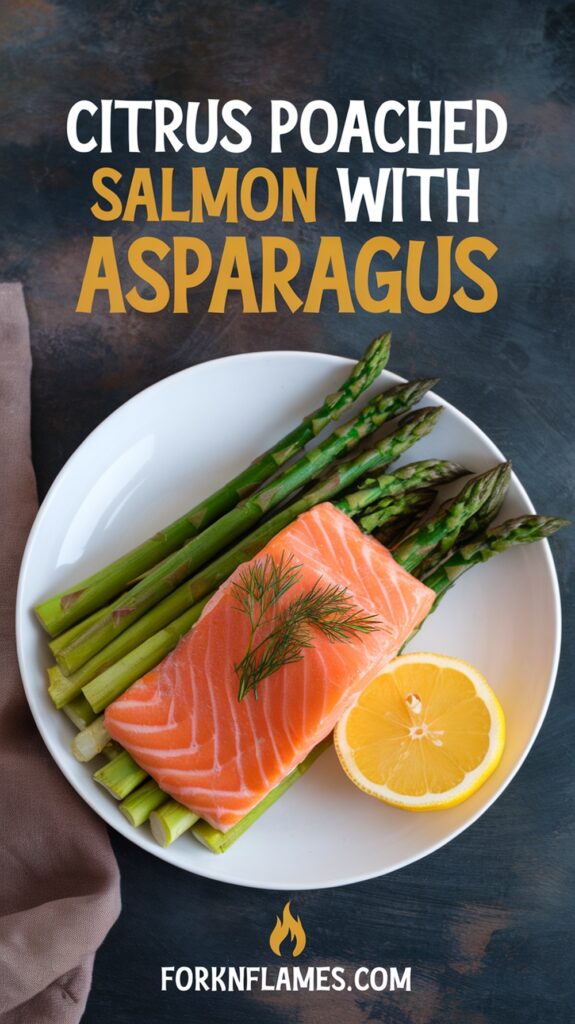
Once you’ve mastered the citrus salmon recipe, the possibilities expand. The asparagus and salmon pairing works with bold or subtle tweaks. Switching up flavors is simple—just adjust the liquid ingredients and seasonings. Here’s how to reinvent your easy salmon dinner:
- Asian Twist: Simmer salmon in ginger, lemongrass, lime, and soy sauce. Garnish with sesame seeds and scallions.
- Mediterranean Style: Infuse the liquid with Kalamata olives, capers, and oregano. Drizzle with Danish Creamery’s Organic Spreadable Butter for richness.
- Herb-Lover’s Dream: Boost the citrus salmon recipe with dill, chervil, and parsley. Toss asparagus with the herbs before serving.
- Spicy Kick: Add red pepper flakes to the poaching liquid. Balance with a lemon-sour cream drizzle.
Try seasonal citrus like blood oranges in winter or grapefruit in summer. For tropical flair, swap water with coconut milk. The easy salmon dinner becomes a canvas: start small, like adding garlic or thyme, then build from there. Even leftover herbs or pantry spices can turn this dish into a weekly favorite.
Conclusion
This Citrus Poached Salmon with Asparagus recipe shows that poaching salmon is easy. It’s perfect for a quick weeknight dinner or a fancy meal for guests. The salmon stays tender, and the citrus and asparagus add a bright, sweet flavor.
Just 8-10 minutes of cooking at 95°C (203°F) makes the salmon flaky and moist. It’s also packed with 38g of protein per serving. Serve it with veggies or grains, and enjoy the leftovers in salads the next day.
Feel free to try different variations. Swap asparagus for zucchini or add herbs like dill. Share your changes in the comments. It’s fun to see how others make this poached salmon dish their own.
This dish is all about letting the ingredients speak for themselves. Fresh salmon, citrus, and asparagus create a perfect harmony. You don’t need heavy sauces. It’s a simple way to make a restaurant-quality meal at home. Your kitchen and taste buds will love it.

